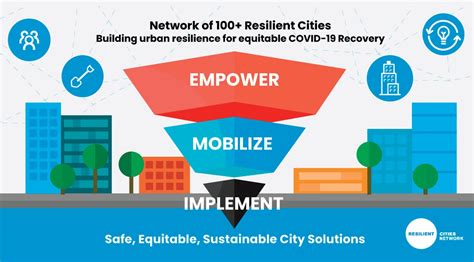In today’s rapidly urbanizing world, the concept of resilience has become increasingly important in the development and planning of cities. As urban populations continue to grow, cities are facing a myriad of challenges, from climate change to socio-economic issues. In this blog post, we will delve into the topic of building resilient cities and explore the key components that contribute to urban planning and development. From understanding the concept of resilience to identifying the challenges in urban planning, and from incorporating climate change adaptation strategies to engaging with local communities, we will examine the various aspects that contribute to the creation of resilient cities. We will also discuss the importance of sustainable infrastructure development, the role of smart technology, and the implementation of effective disaster risk management. Additionally, we will highlight the significance of green building practices, and the building of strong social and economic networks. Lastly, we will explore the methods of evaluating the success of resilient cities. Join us on this journey as we unravel the intricacies of building resilient cities.
Table of Contents
Understanding the concept of resilience
Resilience is the ability of a system to absorb and adapt to disturbances while retaining its functionality. This concept applies to various aspects of life, including urban planning, infrastructure development, disaster management, and social and economic networks. In the context of urban planning, resilience involves creating cities that can withstand and recover from various shocks and stresses, such as natural disasters, economic downturns, and social upheavals.
Urban resilience also encompasses the capacity to bounce back from challenges and to transform adversity into an opportunity for growth and improvement. It requires a holistic approach that takes into account the interconnectedness of social, economic, and environmental factors. By understanding the concept of resilience, city planners and policymakers can develop strategies to build cities that are better equipped to face the uncertainties of the future.
Furthermore, the concept of resilience extends beyond physical infrastructure to encompass the social fabric of a city. It involves fostering strong community bonds, promoting equity and inclusion, and providing support systems for vulnerable populations. By addressing these broader aspects of resilience, cities can create environments that are not only robust in the face of challenges but also nurturing and empowering for their residents.
Ultimately, understanding the concept of resilience is essential for creating cities that are not just capable of surviving, but thriving in the face of adversity, uncertainty, and change.
Identifying the key challenges in urban planning
One of the key challenges in urban planning is managing population growth and urban sprawl. As cities continue to expand, it becomes increasingly difficult to provide adequate housing, transportation, and infrastructure for all residents. This can lead to overcrowding, traffic congestion, and a strain on resources, making it essential for urban planners to find innovative solutions to accommodate the growing population.
Another significant challenge is the need to balance economic development with environmental preservation. Urban areas often face pressure to attract businesses and create jobs, but this must be done in a way that does not harm the natural environment. Finding the right balance between economic growth and sustainability is crucial for the long-term health and prosperity of a city.
Additionally, social equity and inclusivity are important challenges in urban planning. It’s vital to ensure that all residents, regardless of their socioeconomic status, have access to essential services and amenities. This includes affordable housing, public transportation, and healthcare facilities. Addressing these disparities requires deliberate and thoughtful planning to create a city that works for everyone.
Lastly, the rapid pace of technological advancement poses a challenge for urban planners. Incorporating smart technology into urban infrastructure can improve efficiency and convenience, but it also requires careful consideration of privacy, data security, and the potential for inequality. Finding ways to harness the benefits of technology while mitigating its drawbacks is an ongoing challenge in urban planning.
Incorporating climate change adaptation strategies
Climate change is no longer a distant threat – it is a present reality that requires urgent action. As urban areas around the world face the impacts of rising temperatures, extreme weather events, and sea level rise, it has become increasingly important for city planners and policymakers to incorporate climate change adaptation strategies into urban planning and development.
One of the key challenges in incorporating climate change adaptation strategies is the need for long-term thinking and planning. While it may be tempting to focus on short-term solutions, such as building seawalls or implementing emergency response measures, truly resilient cities require a more comprehensive approach that considers the long-term impacts of climate change and the need to build sustainable infrastructure that can withstand these impacts.
Another important aspect of incorporating climate change adaptation strategies is the need to engage with local communities. From flood-prone neighborhoods to heat-vulnerable populations, it is essential to involve local residents in the planning and decision-making process in order to ensure that climate change adaptation measures are effective, equitable, and socially just.
In conclusion, incorporating climate change adaptation strategies into urban planning is a complex but critical task. By building resilient cities that are prepared to face the challenges of climate change, we can create safer, more sustainable, and more equitable urban environments for generations to come.
Promoting sustainable infrastructure development
Promoting sustainable infrastructure development
In today’s rapidly evolving world, the need for sustainable infrastructure development has become increasingly important. As our cities continue to grow and expand, it is crucial that we focus on promoting infrastructure that is not only efficient and reliable, but also environmentally friendly and resilient. This involves incorporating innovative and sustainable practices into the planning, design, and construction of our infrastructure.
One of the key steps in promoting sustainable infrastructure development is to prioritize the use of renewable energy sources such as solar, wind, and hydro power. By embracing clean energy technologies, we can reduce our reliance on non-renewable resources and minimize the environmental impact of our infrastructure projects. This not only helps to combat climate change, but also creates a more sustainable and resilient urban environment.
Additionally, promoting sustainable infrastructure development involves integrating green building practices into construction projects. This includes using environmentally friendly materials, optimizing energy and water usage, and implementing waste management strategies. By doing so, we can reduce the carbon footprint of our infrastructure and create healthier, more sustainable living environments for our communities.
Another important aspect of promoting sustainable infrastructure development is to embrace smart technology and innovation. This includes utilizing digital tools and data-driven solutions to enhance the efficiency, safety, and sustainability of our infrastructure. By harnessing the power of technology, we can optimize our infrastructure systems, improve resource management, and create more resilient and adaptable cities for the future.
Utilizing smart technology for urban resilience
Utilizing smart technology for urban resilience can greatly enhance the ability of cities to adapt and recover from various challenges and disasters. Smart technology, such as sensors, data analytics, and connectivity, can provide real-time information and insights that enable city planners and residents to make informed decisions and respond effectively to different situations.
With the use of smart technology, cities can monitor and manage various aspects of their infrastructure, including transportation, energy, water, and waste management. For example, sensors can be used to detect leaks in the water supply, track traffic patterns, or identify potential hazards in buildings. This data can then be analyzed to improve efficiency, safety, and sustainability in urban areas.
In addition to infrastructure management, smart technology can also be utilized for early warning systems and emergency response. For instance, in the event of a natural disaster, such as an earthquake or flood, sensors can detect changes in the environment and send alerts to residents and authorities, allowing for a quicker and more coordinated response.
Overall, the integration of smart technology into urban planning and development is essential for building resilient cities that can withstand and recover from various challenges, including climate change, natural disasters, and rapid urbanization. By leveraging the power of data and connectivity, cities can become more efficient, sustainable, and adaptable, ultimately improving the quality of life for their residents.
Engaging with local communities in urban planning
Engaging with local communities in urban planning is crucial for the successful development and implementation of sustainable urban projects. Local communities are the ones directly affected by the decisions made in urban planning, and therefore, their input and participation are key to ensuring that these plans meet the needs and aspirations of the people who live and work in these urban environments.
When engaging with local communities in urban planning, it is important to create opportunities for open dialogue and collaboration. This can be achieved through community meetings, workshops, and public forums where residents can express their concerns, ideas, and suggestions regarding the development of their neighborhoods.
Moreover, engaging with local communities in urban planning fosters a sense of ownership and pride among residents. When people feel that they have been heard and that their input is valued, they are more likely to support and participate in the implementation of urban development initiatives.
Overall, engaging with local communities in urban planning is a fundamental component of creating sustainable and resilient cities. By involving the people who live and work in these urban areas in the planning process, we can ensure that the resulting urban projects reflect the needs and aspirations of the community, ultimately leading to more inclusive and successful urban development.
Implementing effective disaster risk management
When it comes to disaster risk management, it is crucial to ensure that strategies and plans are not only in place, but also effectively implemented. The effective implementation of disaster risk management involves a multi-faceted approach that encompasses various aspects of disaster preparedness, response, and recovery.
First and foremost, it is important to conduct thorough risk assessments to identify potential hazards and vulnerabilities within a community or region. This involves gathering data, analyzing historical patterns of disasters, and evaluating the potential impacts of different types of hazards. By understanding the specific risks faced, appropriate measures can be put in place to mitigate these risks.
In addition, effective communication and coordination among relevant stakeholders is vital in disaster risk management. This includes collaboration between government agencies, emergency responders, non-governmental organizations, and community groups. By working together and sharing information, resources and expertise, a more cohesive and comprehensive approach to disaster risk management can be achieved.
Furthermore, investing in infrastructure that is resilient to disasters is a key component of effective disaster risk management. This involves building and maintaining infrastructure such as sea walls, flood barriers, and early warning systems, as well as ensuring that buildings and critical facilities meet strict building codes and standards to withstand disasters. Investing in resilient infrastructure not only reduces the vulnerability of communities, but also ensures a more efficient response and recovery following a disaster.
Adopting green building practices for resilience
Adopting green building practices for resilience is essential in creating sustainable and eco-friendly urban environments. By implementing environmentally friendly building materials and construction techniques, cities can reduce their carbon footprint and mitigate the impact of climate change.
Utilizing sustainable building practices such as solar panels, rainwater harvesting, and energy-efficient design can lead to cost savings in the long run while also promoting a healthier and greener living environment for residents.
In addition, green building practices also play a crucial role in enhancing the resilience of urban areas by minimizing the vulnerability of buildings to natural disasters such as hurricanes, earthquakes, and floods. By constructing buildings that are resilient to environmental hazards, cities can better protect the safety and well-being of their inhabitants.
Furthermore, the adoption of green building practices can contribute to the overall sustainability and livability of urban spaces, creating a more inclusive and environmentally conscious community for future generations to enjoy.
Building strong social and economic networks
Building strong social and economic networks is crucial for the resilience of cities in the face of various challenges. Social and economic networks play a significant role in shaping the fabric of urban communities, and their strength can determine how well a city can withstand adversities.
Strong social networks promote a sense of belonging and encourage collaborative efforts among residents. When people feel connected to one another, they are more likely to provide support and assistance during challenging times. Moreover, a strong social fabric contributes to the overall well-being and mental health of the community.
Similarly, robust economic networks create opportunities for growth and development. When businesses, organizations, and industries are interconnected, they can leverage each other’s resources and support, making the city more resilient to economic shocks and disruptions.
Ultimately, building strong social and economic networks requires collaborative efforts from various stakeholders, including city planners, local governments, businesses, community organizations, and residents. By recognizing the importance of these networks and actively investing in their growth and development, cities can enhance their resilience and create a more sustainable urban environment for all.
Evaluating the success of resilient cities
Resilient cities are those that are able to withstand and recover from a variety of challenges, including natural disasters, economic downturns, and social disruptions. Evaluating the success of these cities involves looking at a range of factors, including their ability to bounce back from adversity, their level of preparedness for future challenges, and the resilience of their infrastructure and communities. The success of resilient cities can be measured through a combination of quantitative data, such as economic indicators and infrastructure quality, and qualitative assessments of community engagement and social cohesion.
One key aspect of evaluating the success of resilient cities is to assess their ability to adapt to a changing climate. This involves examining the effectiveness of their climate change adaptation strategies, such as green infrastructure and sustainable development practices. Additionally, resilient cities must be able to utilize smart technology to enhance their resilience, including implementing effective disaster risk management and utilizing data-driven decision-making processes.
In order to truly evaluate the success of resilient cities, it is essential to engage with local communities and incorporate their perspectives and needs into the assessment process. Building strong social and economic networks within the city is also crucial for resilience, as these networks can provide vital support and resources during times of crisis. By incorporating the voices of local residents, businesses, and community organizations, it becomes possible to gain a more comprehensive understanding of the city’s level of resilience and to identify areas for improvement.
In conclusion, evaluating the success of resilient cities requires a comprehensive and multifaceted approach that takes into account a range of factors, including their ability to adapt to climate change, utilize smart technology, engage with local communities, and build strong social and economic networks. By examining these aspects, it becomes possible to gain a deeper understanding of what makes a city truly resilient and to identify strategies for further enhancing its resilience in the future.





